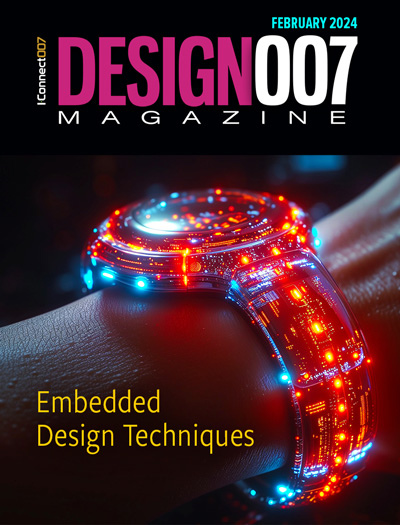-

- News
- Books
Featured Books
- design007 Magazine
Latest Issues
Current Issue
Level Up Your Design Skills
This month, our contributors discuss the PCB design classes available at IPC APEX EXPO 2024. As they explain, these courses cover everything from the basics of design through avoiding over-constraining high-speed boards, and so much more!

Opportunities and Challenges
In this issue, our expert contributors discuss the many opportunities and challenges in the PCB design community, and what can be done to grow the numbers of PCB designers—and design instructors.

Embedded Design Techniques
Our expert contributors provide the knowledge this month that designers need to be aware of to make intelligent, educated decisions about embedded design. Many design and manufacturing hurdles can trip up designers who are new to this technology.
- Articles
- Columns
Search Console
- Links
- Events
||| MENU - design007 Magazine
Just Ask Happy: Calculating Trace Temps in a Vacuum
July 7, 2020 | I-Connect007 Editorial TeamEstimated reading time: 1 minute
We asked for you to send in your questions for Happy Holden, and you took us up on it! The questions you've posed run the gamut, covering technology, the worldwide fab market, and everything in between. Enjoy.
Q: For space applications (without air), how should we calculate external layer current-carrying traces against the IPC-2221 (formerly IPC-D-275) charts?
A: I have never studied that, so I turned this question over to an expert, my friend Mike Jouppi, former committee chair of IPC-2152 Standard for Determining Current Carrying Capacity in Printed Board Design. This standard will provide many answers to your questions. Mike wrote Chapters 22 and 23 in the seventh edition of the Printed Circuits Handbook, edited by Clyde F. Coombs and me.
Mike answered: I'm a mechanical engineer who worked as a career thermal analyst. The charts in IPC-2152 in almost all cases will be conservative (both air and vacuum environments). The vacuum is for space environments. The purpose behind these charts is misconstrued by most users. My intention when they were developed was to use these charts as a baseline for developing thermal models that could be used to better understand the actual temperature rise of conductors in actual designs, which I did for my own design purposes. The concept did not catch on.
There is a significant difference between the temperature rise in a conductor, tested per IPC-TM-2.5.4.1a, and most PWB design configurations. The reason is that most designs have copper ground and power planes that conduct energy away from the traces. In addition, most designs in space applications have a significant conduction path from the PWB through-bolted fasteners or wedge locks to a sink.
Since the question does not include IPC-2152, I would recommend researching IPC-2152 and accounting for the power dissipations in the traces in the thermal design. I also recommend accounting for the conductor power dissipation in all designs, especially if the designers are not familiar with sizing parallel conductors. Parallel conductors are easily managed with accounting for conductor losses (power dissipation). FYI: It was the power dissipation in conductors that motivated me to lead the development of IPC-2152.
To pose your own question for Happy Holden, take the survey by clicking here.
Suggested Items
Designer’s Notebook: What Designers Need to Know About Manufacturing, Part 2
04/24/2024 | Vern Solberg -- Column: Designer's NotebookThe printed circuit board (PCB) is the primary base element for providing the interconnect platform for mounting and electrically joining electronic components. When assessing PCB design complexity, first consider the component area and board area ratio. If the surface area for the component interface is restricted, it may justify adopting multilayer or multilayer sequential buildup (SBU) PCB fabrication to enable a more efficient sub-surface circuit interconnect.
Insulectro’s 'Storekeepers' Extend Their Welcome to Technology Village at IPC APEX EXPO
04/03/2024 | InsulectroInsulectro, the largest distributor of materials for use in the manufacture of PCBs and printed electronics, welcomes attendees to its TECHNOLOGY VILLAGE during this year’s IPC APEX EXPO at the Anaheim Convention Center, April 9-11, 2024.
ENNOVI Introduces a New Flexible Circuit Production Process for Low Voltage Connectivity in EV Battery Cell Contacting Systems
04/03/2024 | PRNewswireENNOVI, a mobility electrification solutions partner, introduces a more advanced and sustainable way of producing flexible circuits for low voltage signals in electric vehicle (EV) battery cell contacting systems.
Heavy Copper PCBs: Bridging the Gap Between Design and Fabrication, Part 1
04/01/2024 | Yash Sutariya, Saturn Electronics ServicesThey call me Sparky. This is due to my talent for getting shocked by a variety of voltages and because I cannot seem to keep my hands out of power control cabinets. While I do not have the time to throw the knife switch to the off position, that doesn’t stop me from sticking screwdrivers into the fuse boxes. In all honesty, I’m lucky to be alive. Fortunately, I also have a talent for building high-voltage heavy copper circuit boards. Since this is where I spend most of my time, I can guide you through some potential design for manufacturability (DFM) hazards you may encounter with heavy copper design.
Trouble in Your Tank: Supporting IC Substrates and Advanced Packaging, Part 5
03/19/2024 | Michael Carano -- Column: Trouble in Your TankDirect metallization systems based on conductive graphite or carbon dispersion are quickly gaining acceptance worldwide. Indeed, the environmental and productivity gains one can achieve with these processes are outstanding. In today’s highly competitive and litigious environment, direct metallization reduces costs associated with compliance, waste treatment, and legal issues related to chemical exposure. What makes these processes leaders in the direct metallization space?


